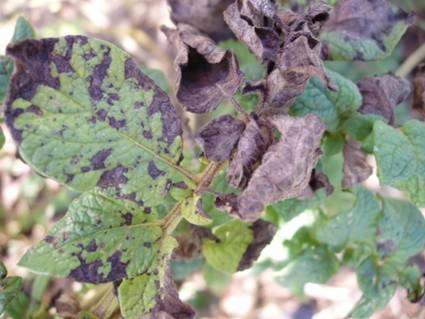
Signum has recently received a new and significant off-label approval for use against early blight or Alternaria in potatoes, in time for the season. Growers will need to obtain a copy of the notice of approval to use Signum in potatoes via the Chemicals Regulation Directorate (CRD) web site, ADAS offices or NFU. The SOLA reference number is 1942 of 2010.
The SOLA relates to the use of Signum (boscalid and pyraclostrobin) for the control of strains of Alternaria (early blight). It should be applied at a maximum individual dose of 0.25 kg/hectare in 200 to 400 litres of water per hectare. Up to 2 treatments per crop/year can be made. The latest time of application is 3 days before harvest.
The important requirement for control is to ensure that applications are applied in a protectant situation at the start of the disease epidemic. As the SOLA is for 2 applications it is suggested that the first treatment is applied when the weather conditions are conducive for disease development. To ensure late blight protection is maintained it may be necessary to apply with an appropriate blight fungicide.
Signum is highly rated for Alternaria control by Euroblight and is given a 3* rating, which is the highest rating.
Background on Alternaria in potatoes:
The disease can be caused by two species – Alternaria solani and A. alternata. Although disputed by some authorities, A. solani is understood to be a truly pathogenic species, while A. alternata is saprophytic to weakly pathogenic. An early infection resulting in heavy disease pressure can result in a yield loss of 20 – 30%.
The typical concentric-ring symptoms appear principally on the leaves, with smaller lesions expanding into larger ovoid lesions, often with a yellow margin. The disease symptoms can be confused with manganese deficiency, magnesium deficiency and ozone damage, which can also produce lesions with concentric-rings.
The disease survives the winter as mycelium and spores which are found in crop and alternate host trash, as well as in the soil or infected tubers. Spores released in the spring act as the primary inoculum source and these can be carried by wind and water, resulting in further disease build up and spread. The disease needs warm wet weather for an epidemic to fully develop as spore production is favoured by alternating wet and dry periods.
In 2009 there was an increase in reported cases of the disease. This may be due to more susceptible varieties being grown. Varieties which have been noted as being susceptible include: Markies, Mimi, Hermies, Vivaldi, Saturna, Maris Piper, Lady Clare and Maris Peer. Or it may be due to weather conditions, with warm days and cool nights during the growing period being conducive to the disease. Other factors that may have contributed to higher risk of Alternaria are reduced nitrogen usage or reduced mancozeb usage.
